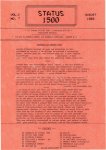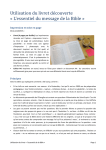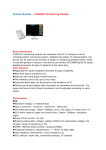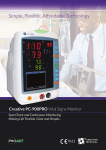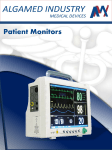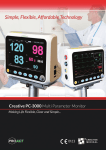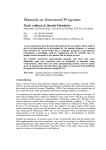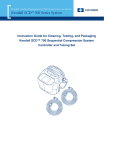Download Operation and Maintenance Manual
Transcript
THAMES MEDICAL CAT Doppler Blood Pressure Kit Operation and Maintenance Manual THAMES MEDICAL experts in patient monitoring, pulse oximetry and doppler technology t: 01903 522911 f: 01903 522922 e: [email protected] www.thamesmedical.com Thames Medical Ltd., Thames House, 8 A’Becket Gardens, Worthing, W. Sussex BN13 2BW experts in patient monitoring, pulse oximetry and doppler technology THAMES MEDICAL Index experts in patient monitoring, pulse oximetry and doppler technology Thank you for choosing the Thames Medical CAT doppler blood pressure determination system, we are confident that it will give you long and useful service. The CAT doppler is the culmination of over four years of work by our development team, which has included the top experts in the fields of Doppler Technology, Veterinary Medicine (specialising in Feline hypertension) and Applied Physiology. Whilst today the CAT doppler is probably the most sensitive and easiest to use doppler in the world, we will continue our development and improvement program and may from time to time make changes from the advertised product. We will not attempt to go into the intricacies of blood pressure in this manual, reserving that for later publications, however we shall attempt to verbalise the manual technique of blood pressure determination which can be used for most species, especially cats and dogs. If you have any doubts, concerns or ideas as to how we may further improve our product, please contact us at: Thames Medical Ltd, Thames House, 8 A’Becket Gardens, Worthing, West Sussex. BN13 2BW Tel: +44 (0)1903 522 911 Fax: +44 (0)1903 522 922 Email: [email protected] www.thamesmedical.com 1 What’s in the box? 2 Controls and indicators 3 Care of your PD1v CAT 4 How to take a blood pressure 5 What is normal blood pressure? 6 Top tips for success 7 How to take a cats blood pressure (picture guide) 8 Guidelines for identifying and resolving adverse EMC conditions 9 Parts and replacement ordering 10 Service and warranty 11 Specifications 12 Other products CAT Manual 6/11 1. What’s in the box? The CAT doppler box should include the following: 1x 1x 1x 1x 1x 1x 1x 1x 1x 1x 1x Cat Doppler unit with HypersenseTM Flat probe Disytest Sphygmomanometer and hose White Neonatal size 1 cuff White Neonatal size 2 cuff White Neonatal size 3 cuff White Neonatal size 4 cuff White Neonatal size 5 cuff Headphones Tube of Ultrasound Gel PP3 Battery Operation and maintenance manual 2. Controls and Indicators 3. Care for your PD1v CAT • • • Simple Fault Finding In the unlikely event of instrument failure, the following simple checks may be made before contacting your supplier or Thames Medical +44 (0)1903 522911 for further advice. • • • • The PD1v CAT is powered from a single 9 volt alkaline battery (type 6LR61/PP3). To insert or change the battery, slide off the battery cover and withdraw the battery and connector. Carefully remove the battery from the connector and snap the new battery into position taking care to ensure correct orientation. Place the battery and connector back into the battery compartment and refit the battery cover. • • • • • • • • • To switch on the PD1vCAT press the centre of the membrane switch located on the front of the PD1vCAT unit. The PD1vCAT will stay on until the on/off switch is pressed again. With the unit on, the volume can be adjusted by the rotary volume control on the edge of the unit. The blood flow signals are detected using the FLAT probe. A Yellow LED indicates the condition of the battery, when illuminated constantly, battery replacement is recommended. The LED will flash momentarily when he unit is first turned on. Velocity signals can be printed on a suitable printer or ECG with an analogue input by attaching the unit optional printer cable to socket - contact supplier for further details CAT Manual 6/11 After each use carefully wipe excess coupling gel from the transducer with a soft tissue. Never use alcohol or any other solvent to clean any part of the Pocket Doppler, as these may cause damage. If cleaning becomes necessary wipe the Pocket Doppler with a damp cloth moistened with a mild detergent. The transducer face is very delicate and may be damaged by dropping. Always store the unit and transducer in carry case. Turn the volume control to maximum. Turn the unit on and observe the Battery Low indicator, if it does not illuminate, replace the battery and try again. If the Battery Low indicator remains on, replace the battery and try again. If the Battery Low indicator illuminates and then goes out (normal operation) stroke the transducer face. If no audio signal is heard in the loudspeaker, consult your supplier or Thames Medical. When contacting your supplier with a problem please have available the instrument type and serial number. The serial number can be found inside the battery compartment. In the event of a failure we operate an out of warranty fixed price repair scheme to give you peace of mind. Probe replacement (very rare) is just £225 +P&P + VAT, all other repairs are just £85.00 + P&P + VAT. Simply call +44 (0)1903 522911 for instructions on where and how to send it order all parts and accessories www.thamesmedical.com CAT Manual 6/11 4. How to take a cats’ blood pressure Dogs Dogs are virtually the same in their normal values as cats, however, there are some authors who claim that certain breeds have a propensity for hypertension, including Lurchers and some Bull Terriers. The author feels that these discrepancies are more related to the superior muscular development of these dogs and less to the existence of any other underlying pathology, but is open to changing his views in the light of evidence. The technique used is an identical one to a human manual technique, with the exception that instead of using a stethoscope to auscultate the sound of the blood in the arteries, we will use the FLAT probe CAT doppler. The pick up comes from the white circle on the probe. * You may wish to isolate the animal in a quite room for a while to reduce the animals stress but in the authors experience this isn’t always necessary. After preparing the probe site to be used (see Top Tips) the probe is positioned distal to the cuff over an artery. One of the easiest reference sites to use is the ‘stopper pad’ on the underside of the animals’ front limb. It is important to keep the long axis of the probe in line with the limb. Little or no pressure is required other than that needed to hold the probe in place. For long anaesthetic cases the probe can be taped in place. The pressure in the cuff is then smoothly increased until such a time as the pulse sounds from the doppler are no longer heard. Continue on for another 10-20 mmHg pressure and then using the red trigger on the back of the sphygmomanometer smoothly and steadily deflate the cuff. At the point that blood sounds can be heard again, read of the pressure on the sphygmomanometer gauge, this is the systolic blood pressure. 6. Top tips for success 1 The Diastolic pressure can also sometimes be determined by a change in tone as the cuff pressure continues to be released, but this is not always possible. IMPORTANT: Remember to always totally deflate the cuff after every attempt to allow venous draining. 2 3 4 5 6 5. What is normal blood pressure? Cats Below 135mmHg Hypotensive 135 – 165mmHg Normal 165 – 185mmHg Borderline Hypertensive Requires further investigation* 185+ Hypertensive As above plus treatment CAT Manual 6/11 If you have an animal whose systolic blood pressure is for example 185 mmHg, it is important to rule out user error or other factors which may be artificially increasing the animals blood pressure (white coat hypertension, travel stress etc). Keep the animal in a quiet corner in the room you are going to do the determination for an hour or so, to allow it to adjust to the surroundings. You may also want to take a blood sample to eliminate any other causes for this elevated reading, it could be genuine hypertension. 7 8 9 10 11 12 13 14 15 Use alcohol or a soap solution to wet the fur down. Air and hair both interfere with doppler ultrasound. If you use alcohol you shouldn’t need to clip, this keeps the animal calmer. Use lots of gel. Put the right sized cuff (they are all marked for size range) ‘below’ the ‘elbow’ the limb is more tubular at this point so the cuff compression is more even, leading to better results. Get the nurse to ‘present’ the limb as if for injection. If the cuff starts to slide down, reposition it and ask the nurse to steady it. (Don’t let the nurse squeeze it though!) Use lots of gel. Be calm and confident in your approach, its amazing what a difference this can make. Hold the probe gently on the patient so as not to occlude the artery being listening to. If the limb is a ‘no go’ try the under tail. When measuring dogs, lie them down, especially Greyhounds, Staffordshire Bull Terriers and other muscular dogs, if you don’t you can pump up the cuff all day and still not occlude the artery. Use lots of gel. If the animal objects to the noise of the doppler use the headphones. Keep a spare fresh battery in the case If doubts persist or skills seem lacking, book a training session with us: 01903 522911. CAT Manual 6/11 7. Technique on cats (picture guide) 1 Doppler BP monitoring equipment from Thames Medical. Note that the width of the inflatable part of the cuff should be around 30 - 40% of the circumference of the limb it is being placed around. CAT Doppler cuffs are all pre marked with a range, there's no need to measure. download the video from www.thamesmedical.com 5 Ultrasound coupling gel should be applied to the area… 6 2 It is important to take the cat’s blood pressure in as stress-free an environment as possible. Ideally, the owner should be present. Blood pressure should be measured after the animal has had a few minutes to settle and before any other procedure, such as clinical examination or rectal temperature taking. … and to the Doppler probe. 7 3 The probe is then held just below the carpal pad and the machine switched on. The position of the probe then needs to be gently altered until you can hear the flow of blood. The cuff should be placed snugly around the forelimb. 8 4 The flow of blood is measured through the common digital artery located between the carpal and metacarpal pads. To get good contact with the Doppler probe, the area should be soaked with spirit. CAT Manual 6/11 Once a clear signal is heard, the cuff is gently inflated to around 20mm of mercury above the point where blood flow can no longer be heard. The cuff is then slowly and steadily deflated. The point where blood flow is first heard again is systolic pressure. The average of five readings is used, and ideally each reading should be about the same. CAT Manual 6/11 8. Guidelines for identifying and resolving adverse EMC conditions Emissions Care has been taken through the design and manufacturing processes to minimise the EM emissions that may be produced by this equipment. However, in the unlikely event that the unit causes an EM disturbance to adjacent equipment, we suggest that the procedure is carried out ‘out of range’ of the affected equipment. 9. Parts and replacement ordering We keep a comprehensive range of spare and additional parts for your CAT doppler including a range of 28 different cuff styles and types. Below are listed the most common ones with their re-order codes. Phone +44 (0)1903 522911 to order (please note for all orders not online and below £50 we ask for payment by credit/debit card) or order online at www.thamesmedical.com SEMI DISPOSABLE WHITE ARDEN Immunity If the user has any doubt regarding the unit’s EM immunity during routine operation, we suggest that the source of EM disturbance is identified and its emissions reduced. If the user has any doubt regarding the identification and resolution of adverse EM conditions, they may contact the following to seek advice: Thames Medical, SERVICE DEPARTMENT, Thames House, 8 A’Becket Gardens, Worthing, West Sussex BN13 2BW Tel: +44 (0)1903 522 911 Fax: +44 (0)1903 522 922 Email: [email protected] www.thamesmedical.com Neo size 1 2101-5084 -01 Pack of 5 £38.50 (or £8.50 each) Neo size 2 2102-5084 -01 Pack of 5 £38.50 (or £8.50 each) Neo size 3 2103-5084 -01 Pack of 5 £38.50 (or £8.50 each) Neo size 3 2103-5084 -01 Pack of 5 £38.50 (or £8.50 each) Neo size 5 2105-5084 -01 Pack of 5 £38.50 (or £8.50 each) HOKANSON HAND BUILT LATEX CUFFS 1.6cm width 2989-1015-00 Pack of 5 £250.00 1.9cm width 2989-1016-00 Pack of 5 £250.00 2.5cm width 2989-1017-00 Pack of 5 £250.00 Slip luer adapter 5082-169-01 Pack of 5 £7.50 Slip luer connector 5082-176-01 Pack of 5 £7.50 Each £85.00 Each £35.00 CONNECTORS SPHYGMOMANOMETER Spiedel and Keller 2052-09-189 HARD SHELL CARRY CASE Blue carry case order all parts and accessories www.thamesmedical.com CAT Manual 6/11 2001-04-18 NB: All prices in this manual are correct at time of print. Prices are subject to change. CAT Manual 6/11 10. Service and warranty Service A service manual for this equipment, which includes circuit diagrams, parts lists and test procedures, is available and may be purchased from your supplier. Alternatively the unit may be returned to your authorised Service Dealer or to Thames Medical for service. Warranty Your PD1vCAT Pocket doppler is guaranteed for a period of 3 years against defects in material and workmanship. Any instrument that proves to be defective within that period will be repaired or replaced free of charge, provided that: i) The instrument has not been damaged accidentally or by misuse or mishandling. ii) No unauthorised attempts at repair have been made. iii) The goods are returned to Thames Medical Ltd or its authorised representative in its original packaging freight pre-paid. Under no circumstances whatsoever shall Thames Medical Ltd have any liability for loss or for any indirect or consequential damage. For an out of warranty repair we operate a speedy fixed price repair scheme to give you peace of mind. Probe replacement (very rare) is just £225.00 +P&P + VAT, all other repairs are just £85.00 + P&P + VAT. Simply call +44 (0)1903 522911 for instructions on where and how to send it. This Equipment complies with the essential requirements of the European Council CE 0120 Directive 93/42/EEC, WEEE Directive and RoHS. 11. Specifications ULTRASOUND Frequency: 8 MHz continuous wave Transducer: 2 crystal narrow beam Output Power: <50mW/cm2 SATA Audio Response: 300Hz – 4KHz UNIT CONTROLS Keys: 1 Key (for unit on / off) Controls: Rotary volume Indicators: Yellow battery low LED POWER SUPPLY Battery: MN1604 (PP3) 9V Alkaline Manganese Expected battery life:> 9 hours of use OUTPUT Headset: Audio output to optional headset. Recorder: Voltage output proportional to velocity of flow 1mV/KHz ENCLOSURE Material: ABS Size: 150mm by 75mm Weight: 350g typically including transducer SAFETY Classification: Class 1 Type B - IEC 60601-1 experts in patient monitoring, pulse oximetry and doppler technology CAT Manual 6/11 CAT Manual 6/11







